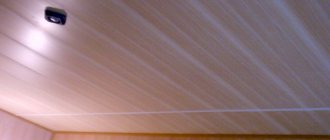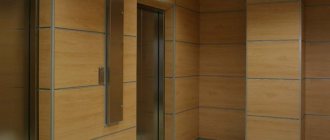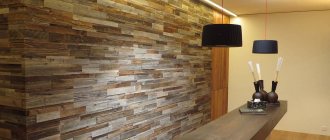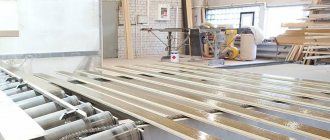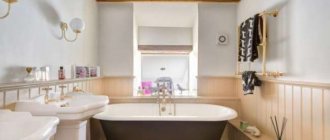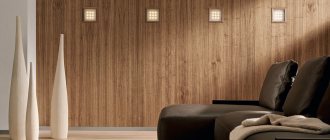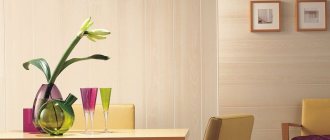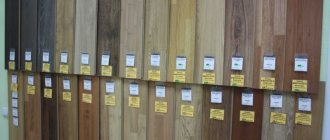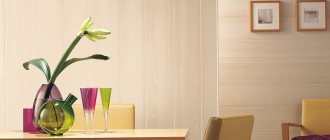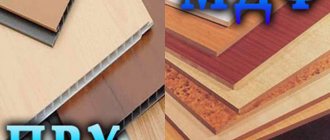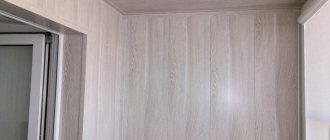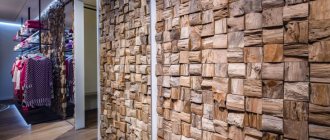Where are veneered wall panels used?
Veneered wall panels can be made from both wood and various boards. They make it possible to create extraordinary design solutions that look solid and elegant to guests, and will be very budget-friendly for the owner.
Among the areas of application the following objects can be distinguished:
- apartments and residential premises;
- offices;
- administrative buildings;
- entertainment and public facilities.
The wide range of applications of these materials is due to their high performance and aesthetic qualities. In addition, they are distinguished by their wide price range, which will satisfy the needs of most buyers.
MDF panels
Veneered MDF boards are visually very similar to wood, but are much cheaper. MDF boards are made from finely ground chips, which are compressed under pressure at high temperatures. No chemical adhesives are used for gluing; during heat treatment, the chips release a natural adhesive, lignin. The resulting slab is sanded crosswise and then lengthwise - this is how a perfectly smooth surface is obtained. Then it is ironed with a special hot roller and painted with varnish or colored paint. Finally, the surface is covered with wax. All these procedures help improve the qualities of the material such as strength and moisture resistance.
Designers love veneered MDF panels, as they provide great opportunity to implement a variety of ideas. There are a huge number of colors and textures of this material on sale. They are used to decorate the ceiling and walls of living rooms, hallways, bedrooms, offices and other rooms. Some types of veneered MDF allow you to reproduce an original panel, mosaic or a unique pattern on the ceiling or wall. Such panels have other advantages:
- attractive and solid appearance: they are difficult to distinguish from natural wood;
- simplicity and ease of maintenance: just wipe the contaminated surface with a damp cloth; a broken plate can be easily replaced;
- good soundproofing and thermal insulation qualities;
- ease of installation, which does not require any labor-intensive preparation of the walls;
- a light weight;
- environmental cleanliness;
- low water absorption;
- Fade resistance.
Characteristics and properties
Veneered panels demonstrate high performance and technical characteristics.
Among the main properties are the following: biostability, heat resistance and the ability to repel moisture. Such slabs are completely suitable not only for external, but also for internal work, since they do not harm people in the room.
Chipboard panels
Chipboard wall panels are also used for interior decoration. This is the cheapest type of veneered finishing materials, since they are based on chipboard. It is obtained by pressing dry wood chips with the addition of synthetic adhesive resins. Veneering occurs in the same way as with MDF boards. The advantages of chipboard material are:
- low price;
- ease of maintenance and installation;
- a large abundance of all kinds of colors and shapes.
But veneered chipboard panels have many disadvantages:
- weak environmental performance;
- absorb moisture;
- heavy weight;
- low quality compared to other veneered panels.
To increase the moisture resistance of chipboard material, it is coated with plastic. In this case, the panel can have any appearance - from imitation oak to bright acid shades.
How to choose veneer panels for walls
The issue of choosing veneer panels in each individual case should be decided based on the individual preferences of a particular craftsman and the characteristics of the desired room.
General criteria that can be used to guide your selection are:
- location of panels;
- color spectrum;
- interior of the room;
- price;
- properties and characteristics.
Regardless of the chosen option, the result will be equally high-quality in properties and attractive in appearance.
Features of the finishing process
The process of installing the structure is quite simple, but to begin it, many conditions must be met. They relate mainly to the parameters of the walls being processed.
Wood in the interior always looks expensive and noble
By the time of installation, all floors must undergo basic preparation and be free from defects:
- cracks;
- chips;
- unevenness;
- differences in plane levels;
- misaligned corners.
Attractive appearance of the kitchen thanks to the combination of white and mahogany
Advice! In addition to this, components of related systems, for example, lighting and power supply, should be prepared if their parts will be visible on the floors.
Veneer made from valuable wood species - a unique balance of price and quality
When the surfaces are ready for decorative finishing, we begin preparing the project, the basis for which is measurements of the room.
Advice! It is recommended to carry them out using a laser level, since measurements made with a tape measure will give a significant error, which is unacceptable in this case, because its appearance will lead to the creation of additional difficulties in the step-by-step installation of the components.
For example, the most common problem in this case is trimming wood and metal. It will require additional equipment, such as miter saws, which are not available in every home.
Decorating the walls with wood will become the “highlight” of any room
What are veneered decorative panels combined with?
When deciding on the use of decorative panels, users wonder what is best to combine them with. Among the options with which the panels are best combined, the following points can be highlighted:
- painting;
- wallpaper;
- plaster.
It is desirable that the combination be performed in the same color composition. Depending on the characteristics of the room, combining decorating styles can produce a striking effect. In addition to improving aesthetic qualities, such combinations can also have practical benefits, for example, hiding wires and communications.
What types of panels are there?
Based on size and shape, panels are divided into:
- rack and pinion;
- tiled;
- leafy.
Slat panels are long slats of varying lengths, thicknesses and widths. This type is most popular when decorating walls or ceilings in small spaces. Installation of slatted veneer panels is carried out on wooden or metal guides using self-tapping screws or staples. The slats are laid so that they are perpendicular to the guides. The planks are connected to each other using the tongue-and-groove method. In this case, there will be a minimum gap between them. In the corner, the slats are joined using special fittings.
Tile materials are produced in the form of squares. This is the most convenient form of ceiling panels. They are attached to the wall using glue or special clamps. The main advantage of tile panels is that they can be placed at different angles and thus create an original pattern.
Sheet panels are the largest, made in the form of rectangles. They are usually made from resin-impregnated fiberboard or chipboard. Sheet plates have a multilayer structure, on top of which a pattern is applied. This can be imitation wood, tiles and other options. They are mounted to the wall using glue. The gaps between the sheet panels are hidden with moldings. Such slabs are very convenient for covering a large area in a short time.
Decorative veneer panels can differ not only in shape and shade, but also in texture. Thanks to modern technologies, you can find smooth, rough, glossy or matte options on sale.
Wall finishing with wood veneer: stages of work
First of all, veneer finishing involves pre-treatment of the walls.
The surface must be leveled, sanded, degreased and free from any defects. This is an important point that directly affects the quality of fastening the panels to the walls. After preparing the base, you will need to prepare the veneer itself:
- unpack;
- make markings;
- cut veneer sheets.
In this case, the minimum number of seams should be achieved. It should be remembered that veneer sets are divided into simple and figured. The first ones have a smooth right side, which is glued to the left side of the next sheet. In this case, the direction of the fibers will be parallel, and the pattern and texture will be symmetrical. In the second case, we are talking about patterns, geometric and other figures.
After preparation, glutinous glue is applied to the base, and then the veneer is laid diagonally or across the base. This must be done because the veneer is strongly tightened with glue and after drying, small cracks may form on the surface.
Make sure that the glue does not bleed through the veneer, especially if you are working with thin material. In some situations, it is better to let the glue dry on the base before attaching the veneer. The sheets are laid overlapping each other. To avoid unraveling of the seams during the work, it is recommended to fasten them, for example, with adhesive tape.
After gluing, the veneer should be ground using a special lapping hammer. Movements should be made along the fibers, from the middle of the sheet and towards its edges. In this case, you should strive to squeeze out excess glue, if any.
Advantages and disadvantages
Any type of coating used in wall decoration has many advantages and, of course, is not without its disadvantages. Here the veneer wall decoration will not stand out in any way. First, let's see what positive aspects such a design will have:
- Almost no other material, with the exception of real wood, can achieve such a solid effect and beauty.
- In almost all cases, this will be a natural finishing option, and the presence of non-natural components in the panels can be ignored. The exception is panels based on chipboard.
- You will significantly improve the situation with heat retention in the rooms, and also reduce the amount of extraneous noise penetrating into them.
- Your walls will last a very long time if they are properly looked after - moisture is the enemy of wood and its contact even with laminated parts is best minimized.
- Cutting and fitting individual parts is not a difficult task. For this you need a simple tool, and not even the most experienced craftsman can handle the job.
- Since the elements will be fastened to the frame, as in other similar structures, you will have space for hidden installation of communications - pipes, wires and all that.
Despite the existing advantages, veneer finishing has very few disadvantages: low water resistance, low combustion resistance and high cost. The disadvantages are completely offset by the existing positive qualities of such a finish.
How to care
It should be noted that for care use products recommended by the manufacturer. It is important to remember that household chemicals and detergents containing hard abrasive particles cannot be used, otherwise the surface of the panels may be damaged. It is also not recommended to use products containing solvents.
The article discusses the feasibility of using wooden panels for wall decoration, their features and the possibility of combining them with other options.
Operation and care
On a note! Caring for decorative wall coverings is simple. It comes down to simple cleaning without the use of auxiliary detergents and cleaning products, which should be taken into account when organizing repairs in institutions where children often visit for long periods of time.
The basis for this type of finishing is MDF sheets. They are made not only from natural components, but also using polymer compositions, which increase the service life of the finished product and simplify assembly work. Thanks to this, cutting workpieces is simplified and does not produce unnecessary waste, which is especially important considering the final cost.
This type of wall covering is resistant to fading, high humidity and ultraviolet radiation.
Advantages and disadvantages
Before choosing any building material, you need to familiarize yourself with its advantages and disadvantages.
Advantages of MDF panels
- Availability. Easily found at most hardware stores or specialty markets.
- Low cost. The total cost of the purchased material will be less than most analogues.
- Ease of installation. The simplicity of the design allows you to install MDF panels quickly and without problems. Even a person with no experience can do this job if they have the necessary tools.
- Presentable appearance. The appearance of MDF panels looks extremely solid, especially the colors that match expensive wood species.
- Additional thermal insulation and sound insulation.
- Safe composition. Do not contain substances harmful to human health.
Flaws
- Fire hazardous. Made from wood components, the panels can catch fire when exposed to flame.
- Poor moisture resistance. A damp indoor environment is not the best option for placing MDF panels. Long-term exposure to a humid environment negatively affects the structure of the material, it swells and bends.
Installation work
Facade veneer panels are used extremely rarely. Basically, they are used to decorate walls. There are three main ways to install a veneer panel: gluing, installation on a connecting profile, or on clamps when using decorative rustication.
- Gluing. This method is only suitable for flat and smooth walls, which, for example, are lined with plasterboard. If the surface is uneven, it is necessary to install a frame with metal or wooden guides.
- Installation on aluminum profiles. The panels are attached end-to-end or on the visible side of the profile, which performs a decorative function. It is not necessary to paint the profile itself. The work is done simply: the profile is attached to the frame in increments of the length of the panel, the panel itself is inserted into its grooves. If the wall is flat, then there is no need to install sheathing; profiles are sufficient.
- Use of decorative connecting strips. Rust is used to hide fasteners. In this way, a three-dimensional surface is achieved, which serves as an excellent interior decoration. The rustication can be made of metal or veneered MDF. A particularly interesting effect can be achieved by choosing panels that are a shade lighter than the decorative strips.
Installation of veneer panels
Facade veneer panels are rarely used, but if desired, they can be included in the exterior. These designs need to be carefully considered as they do not meet all the properties required for external upholstery.
Veneered wall and ceiling panels are one of the most popular materials for finishing apartments and houses today. The use of wood in the interior is considered a classic, proven over the years. Wood is a universal and environmentally friendly raw material. But sometimes the use of natural wood is irrational or impossible for some reason. In this case, it is wise to opt for specially prepared panels.
Varieties
In the interior of an apartment today you can find original solutions, for example, wall cladding with wood, but if you cannot afford natural materials, you should choose veneer cladding. It is offered for sale in several varieties. The material may be tangential. Its peculiarity lies in a special cutting method, which is carried out tangentially. If you want to decorate the walls while saving money, you should choose this particular variety, since it has a low cost. You can recognize such veneer by its wave-like pattern.
The finishing can also be done with radial veneer. Here sawing occurs through the very core of the trunk. The material is obtained with higher quality, it has the characteristics of resistance to various influences, and its structure is homogeneous. Such finishing will cost more, but the quality is higher. As for sawn veneer, it is produced using high-precision equipment. The resulting veneer sheets are geometrically correct, and the thickness of each of them is ideal. This veneer is characterized by wear resistance.
Stone veneer
Another type of material called veneer is stone veneer. It is based on slates. The thickness of the finished stone product can reach 2 mm. This finish is widely used when installing not only on walls, but also on the floor. Stone veneer is used to make furniture items, as well as interior elements for premises for various purposes. The base is stone, so the finish looks very presentable.
The stone at the base of such wood-look cladding can be not only natural, but also artificial. The first has all the advantages that can be inherent in a stone:
- fire resistance;
- abrasion resistance;
- waterproof.
The same cannot be said about wood. But it is warm to the touch and has the qualities of sound and heat insulation. Creating a design and decorating premises using these solutions is undoubtedly a successful solution, which cannot be compared with modern analogues made in imitation wood or stone.
Formats and prices:
Depending on the purpose of use, the thickness of the material should be selected correctly. The thickness of veneered MDF varies from 3 to 50 mm. More detailed information about sizes is available here
.
We are ready to fulfill orders according to standard formats, as well as based on the sizes specified by the customer. Our production facilities allow us to accept orders of any level of complexity.
The order fulfillment time is 3-10 days. The exact figure is determined by the workload of our production.
| See prices for veneering all types of veneer here Full price list in Excel format (36 Kb) |
| (prices are indicated in rubles per square meter for standard panels) |
| Formats | Veneer | Beech | European oak AM* | European oak AB** | European oak AA*** | White ash AB** | White ash AA*** | Far Eastern ash | anegri | birch | |
| MDF-3 | 2440*600 2440*910 2800*686 2800*1032 2800*1220 2800*847 | single-sided | 585 | 648 | 648 | 648 | 620 | 620 | 641 | 837 | 879 |
| two-sided | 816 | 830 | 886 | 942 | 823 | 886 | 928 | 1320 | 1404 | ||
| MDF-4 | 2440*600 2440*910 2800*686 2800*1032 | single-sided | 596 | 659 | 659 | 659 | 631 | 631 | 652 | 848 | 890 |
| two-sided | 827 | 841 | 897 | 953 | 834 | 897 | 939 | 1331 | 1415 | ||
| MDF-6 | 2440*6002440*910 2800*686 2800*1032 2800*1220 2800*847 | single-sided | 651 | 714 | 714 | 714 | 686 | 686 | 707 | 903 | 945 |
| two-sided | 882 | 896 | 952 | 1008 | 889 | 952 | 994 | 1386 | 1470 |
More information about the material
It doesn’t matter whether we are talking about finishing the facades of your kitchen, the surface of interior doors, or wall cladding - the same veneer is used in these cases. It is applied to MDF or other surfaces using hot pressing, achieving high-quality and durable adhesion.
The veneer itself is the thinnest cut of wood, preserving the entire texture of this natural material. The idea of using such a product was expressed a very long time ago, but for a long time mass production of high-quality veneer was impossible due to the lack of high-precision machines capable of delicately working with different types of wood.
As for the raw materials for the product, a wide variety of wood can be used, from accessible and common to rare and even exotic wood species. The final price also depends on this, making veneer a product presented in a wide variety of price categories - from very cheap to elite.
Important! There is an exception to the previous paragraph - this is fine-line veneer. This product is made from natural, but inexpensive wood, after which it is painted, pressed, glued or other measures are performed to change the texture to suit various elite varieties, or to achieve an appearance that is generally difficult to obtain from untreated wood. The product is distinguished by its variety of appearance and at the same time affordable price.
